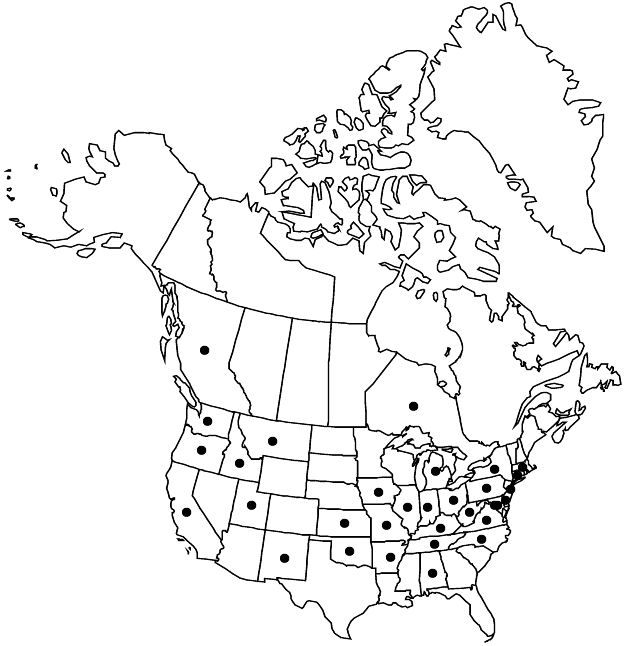Difference between revisions of "Prunus mahaleb"
Sp. Pl. 1: 474. 1753.
FNA>Volume Importer |
imported>Volume Importer |
||
| (2 intermediate revisions by 2 users not shown) | |||
| Line 28: | Line 28: | ||
|elevation=0–2300 m | |elevation=0–2300 m | ||
|distribution=B.C.;Ont.;Ala.;Ark.;Calif.;Conn.;Del.;D.C.;Idaho;Ill.;Ind.;Iowa;Kans.;Ky.;Md.;Mass.;Mich.;Mo.;Mont.;N.J.;N.Mex.;N.Y.;N.C.;Ohio;Okla.;Oreg.;Pa.;Tenn.;Utah;Va.;Wash.;W.Va.;Eurasia. | |distribution=B.C.;Ont.;Ala.;Ark.;Calif.;Conn.;Del.;D.C.;Idaho;Ill.;Ind.;Iowa;Kans.;Ky.;Md.;Mass.;Mich.;Mo.;Mont.;N.J.;N.Mex.;N.Y.;N.C.;Ohio;Okla.;Oreg.;Pa.;Tenn.;Utah;Va.;Wash.;W.Va.;Eurasia. | ||
| + | |introduced=true | ||
|discussion=<p><i>Prunus mahaleb</i> was introduced to North America as a rootstock for commercial cherries and is now sometimes cultivated for its attractive and fragrant flowers. At one time, the aromatic wood was a favorite for tobacco pipes.</p> | |discussion=<p><i>Prunus mahaleb</i> was introduced to North America as a rootstock for commercial cherries and is now sometimes cultivated for its attractive and fragrant flowers. At one time, the aromatic wood was a favorite for tobacco pipes.</p> | ||
|tables= | |tables= | ||
| Line 52: | Line 53: | ||
|publication year=1753 | |publication year=1753 | ||
|special status=Introduced | |special status=Introduced | ||
| − | |source xml=https:// | + | |source xml=https://bitbucket.org/aafc-mbb/fna-data-curation/src/2e0870ddd59836b60bcf96646a41e87ea5a5943a/coarse_grained_fna_xml/V9/V9_597.xml |
|subfamily=Rosaceae subfam. Amygdaloideae | |subfamily=Rosaceae subfam. Amygdaloideae | ||
|tribe=Rosaceae tribe Amygdaleae | |tribe=Rosaceae tribe Amygdaleae | ||
Latest revision as of 22:57, 5 November 2020
Shrubs or trees, not suckering, 30–150 dm, not thorny. Twigs with terminal end buds, densely puberulent. Leaves deciduous; petiole 4–20 mm, glabrous or ± puberulent on adaxial surface, sometimes glandular distally, glands 1–2, discoid; blade broadly ovate, oblong, or suborbiculate, 1.9–4.5 × 1.2–3.4 cm, base usually rounded to truncate, sometimes subcordate, margins crenate, teeth blunt, glandular, apex abruptly acuminate, apicula obtuse, surfaces usually glabrous, sometimes midribs and veins hairy abaxially. Inflorescences 4–10-flowered, corymbs; central axes 8–40 mm. Pedicels 6–18 mm (subtended by leafy bracts), glabrous. Flowers blooming at leaf emergence; hypanthium conic-campanulate, 2–3 mm, glabrous externally; sepals reflexed, oblong, 1.3–2 mm, margins entire, surfaces glabrous; petals white, elliptic to obovate, 6–7 mm; ovaries glabrous. Drupes dark red to black, ovoid, 6–10 mm, glabrous; mesocarps leathery; stones ellipsoid to subglobose, ± flattened. 2n = 16.
Phenology: Flowering Apr–May; fruiting Jun–Jul.
Habitat: Roadsides, stream banks, limestone bluffs and quarries, lowland thickets and woods, fencerows, chaparral
Elevation: 0–2300 m
Distribution

Introduced; B.C., Ont., Ala., Ark., Calif., Conn., Del., D.C., Idaho, Ill., Ind., Iowa, Kans., Ky., Md., Mass., Mich., Mo., Mont., N.J., N.Mex., N.Y., N.C., Ohio, Okla., Oreg., Pa., Tenn., Utah, Va., Wash., W.Va., Eurasia.
Discussion
Prunus mahaleb was introduced to North America as a rootstock for commercial cherries and is now sometimes cultivated for its attractive and fragrant flowers. At one time, the aromatic wood was a favorite for tobacco pipes.
Selected References
None.